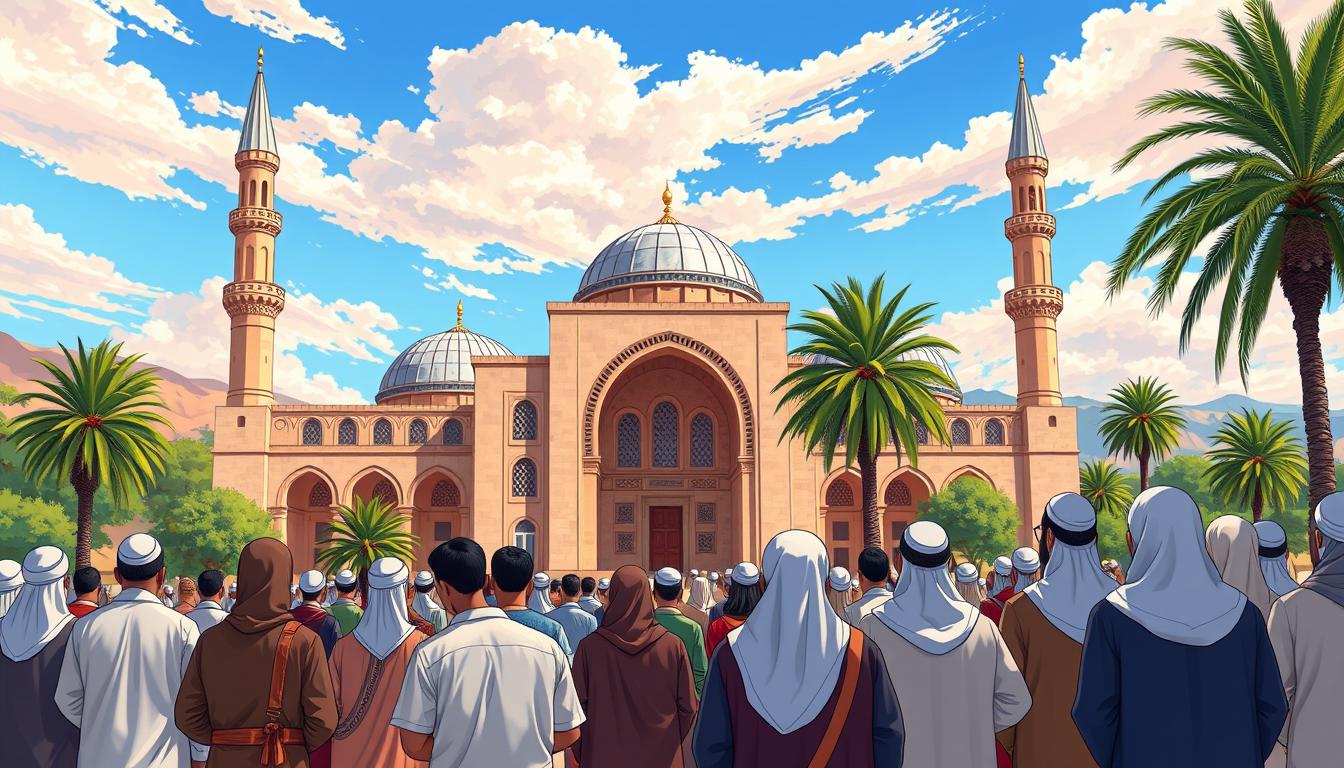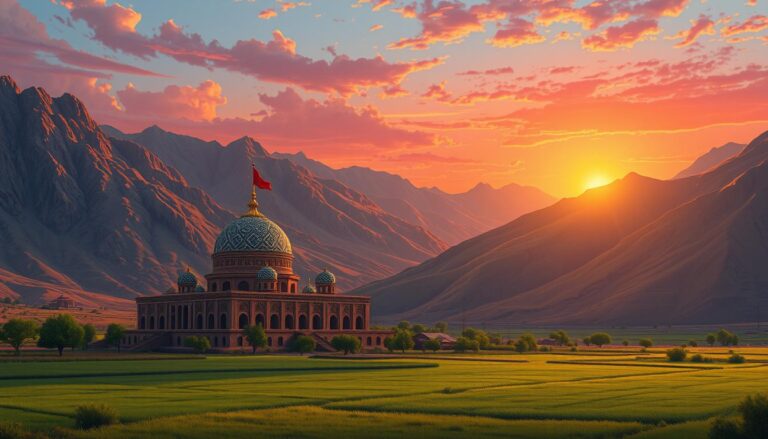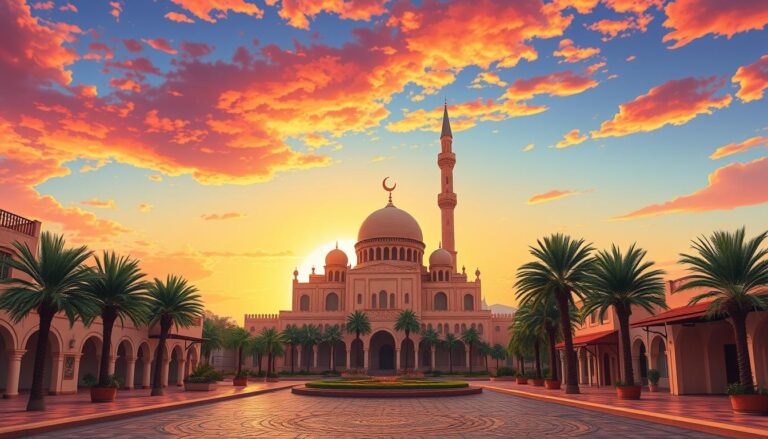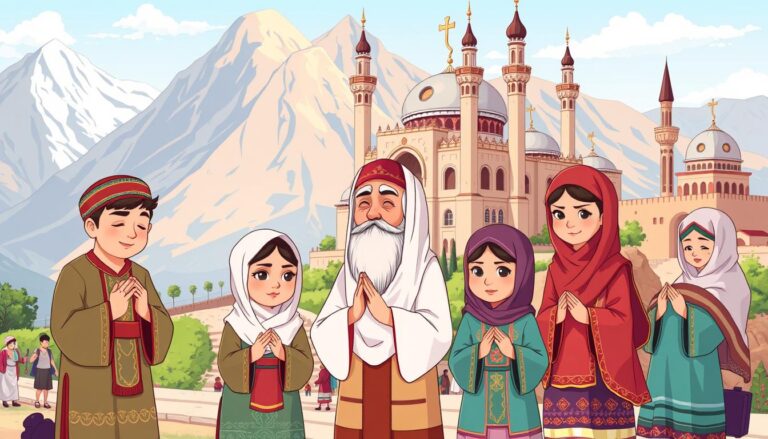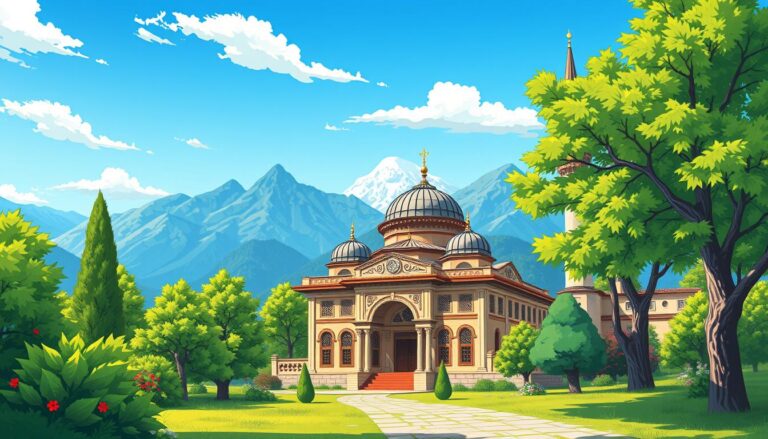Islam in Libya
Islam is the main religion in Libya, with more than 97% of people following Sunni Islam. The 2011 Constitutional Declaration made Islam the state religion. Sharia law is the main source of laws in Libya. There are also small groups of Ahmadis and Shias, mostly Pakistani immigrants, but they are not officially recognized.
Libyan Islamic culture has deep roots, going back to the 7th century. The mix of old beliefs and Islam has created Libya’s unique Islamic traditions. Mosques, schools, and Sufism have greatly shaped Libyan society.
Introduction to Islam in Libya
Islam has been a big part of Libya for centuries. It has shaped the country’s culture, society, and politics. The Islamic faith deeply influences Libyan art, architecture, customs, and traditions.
Prevalence of Sunni Islam
In Libya, Sunni Muslims make up 90 to 95 percent of the population. Sunni Islam is the main religion in the country. Its teachings and practices deeply affect the lives of Libyans.
Constitutional Status of Islam
The 2011 Constitutional Declaration of Libya says Islam is the state religion. Sharia (Islamic law) is the main source of laws. While Christians and Jews have freedom to practice, Islam is the core of Libya’s laws and society.
“Islam has been an integral part of Libyan identity for centuries, shaping the nation’s values, traditions, and way of life. The prevalence of Sunni Islam and the constitutional status of Sharia law are key components of the country’s rich Islamic heritage.”
Historical Background of Islam in Libya
The story of Islam in Libya began in the 7th century. After Prophet Muhammad’s death in 632 AD, Arabs started conquering North Africa, including Libya. Caliph Umar ibn al-Khattab took Libya in 642 AD, thanks to earlier invaders and weak Byzantine rule.
Islam’s arrival in Libya mixed with the local beliefs. Imams and missionaries worked with the people, especially the Berbers. They were influenced by Bedouin tribes from Egypt and Arabia.
Soon, Libya’s cities became more Islamic. But, it took time for Islam to reach the Sahara’s nomads. This happened after Bedouin tribes invaded in the 11th century. Old beliefs, like honoring local saints and believing in jinns, merged with Islam.
“The history of Islam’s arrival and spread in Libya is closely intertwined with the region’s pre-Islamic traditions and the influence of neighboring Arab societies.”
The history of Islam in Libya is well-documented. Many studies and references offer insights into how Islam spread and mixed with old beliefs.
Islam During Gaddafi’s Rule
Under Gaddafi, orthodox Islam’s role in Libya grew. Gaddafi, a devout Muslim, aimed to make Sharia the legal system’s base. He banned “immodest” acts and dress, and cleaned mosques.
Restoration of Sharia Law
From 1969 to 2011, Gaddafi introduced Sharia-based laws. These included punishments for theft, adultery, and drinking. He also improved women’s rights, like allowing them to be judges before men in other Arab states.
Gaddafi’s Interpretation of Islam
But Gaddafi had unorthodox views on hadith, Sharia, and the Islamic era. This made many question his faithfulness to the Quran and Islamic traditions. It made him a controversial figure in Libya.
“Gaddafi was a highly devout Muslim and believed in restoring Sharia as the basis of the Libyan legal system, banning ‘immodest’ practices and dress, and symbolically purifying mosques.”
Islam in Libya
Islam is the main religion in Libya, with Sunni Islam being the most common. The country has a Muslim population of over 96.6%. This makes Libya a key place for Islamic faith in the area. Besides Sunni Muslims, there are also Ibadi Muslims, Christians, and Baha’is.
Sufism, a mystical part of Islam, is practiced in Libya too. Libyans hold public Sufi celebrations in cities like Tripoli and Zliten. These events show the variety of Islamic practices in Libya. They add to the country’s rich cultural mix.
“Tripoli is a city of mosques, and the Mawlai Mohammad Mosque is one of the largest in the city, reflecting the central role of Islam in Libyan society.”
While Sunni Islam is the biggest, Libya also has Shia Muslims. Shia Muslims make up 10-20% of Muslims globally. This diversity makes Islam in Libya today more complex and interesting.
The role of Islam in Libya has changed over time. This is due to shifts in leadership and how religion and state interact. Knowing about Libyan Islamic practices and Libyan Muslim communities helps us understand Libya’s society and culture better.
Legal Framework and Religious Freedom
Libya’s laws show how important Islam is in the country. The 2011 Constitutional Declaration makes Islam the state religion. It also says Sharia law is the main source of laws.
This declaration lets Christians and Jews practice their faiths and handle family matters. But, it doesn’t give the same freedom to other minority groups.
Constitutional Provisions
The Libyan constitution highlights the state’s Islamic identity. The 2011 Constitutional Declaration states, “Islam is the religion of the State, and the principal source of legislation is Islamic Jurisprudence (Sharia).” This has greatly influenced the laws on religious practices in Libya.
Restrictions on Non-Islamic Practices
Libyan law limits activities seen as opposing the Islamic identity. For example, insulting Islam or Muhammad is illegal. Also, publishing anything that tries to change the constitution or social rules is banned.
These laws have stopped missionary work and the spread of non-Islamic religious materials.
The legal system in Libya, shaped by Islam, affects the religious freedom and religious practices of minority groups. The Libyan constitution and Islamic law in Libya set the limits of religious expression and freedom.
Religious Demographics
Libya’s religious scene is mostly Sunni Muslims. The government says Sunni Muslims make up 90 to 95 percent of the people. The Ibadi Muslims are the second largest, with 4.5 to 6 percent, mostly in Jebel Nefusa and Zuwarah.
Minority Religious Groups
Libya also has small minority religious groups. There are over 60,000 Coptic Orthodox Christians and about 50,000 Roman Catholics. There are also other Christian groups, with around 80 regular churchgoers and one Greek Orthodox archbishop.
There are also smaller communities of Hindus, Baha’is, Buddhists, and Ahmadi Muslims, mostly foreigners. Some Libyan Muslims also follow Sufism, a mystical part of Islam.
“The Libyan population includes 50,000 Roman Catholics, led by two bishops.”
The religious demographics in Libya have been influenced by history. The country’s Jewish community left in the mid-20th century. Today, only one Jewish woman remains, due to anti-Semitic laws and violence.
Libya’s religious makeup shows its diverse culture and history. Knowing about the Sunni Muslim majority and minority religious groups helps us understand Libya’s religious scene better.
Christianity in Libya
Christianity is a minority in Libya, with the Coptic Orthodox community being the largest. This group is made up of Egyptian immigrant workers. They make up more than half of Libya’s Christians, with around 60,000 members.
Other Christian groups, like Roman Catholics and Anglicans, are smaller. They are mostly foreign workers and migrants. The Roman Catholic community has about 40,000 members. Smaller groups, such as Russian Orthodox and Pentecostal believers, make up a smaller part of the Christian population.
Coptic Orthodox Community
The Coptic Orthodox community lives mainly in urban areas. They have three main churches in Tripoli, Benghazi, and Misrata. These churches are important for their spiritual and cultural needs, offering a sense of community in a challenging environment.
Other Christian Denominations
While the Coptic Orthodox community is the largest, other denominations also exist in Libya. These include Roman Catholics, Anglicans, and smaller groups. They face similar challenges, including persecution and violence.
The Christian population in Libya is small, making up only 0.5% of the total population. They live in a dangerous environment due to political instability and the dominance of Islam. Despite these challenges, organizations like Open Doors support them, offering vital services and resources.
“Libya was ranked as the 3rd most dangerous country in the world to be a Christian in 2023.”
Judaism and the Jewish Community
Libya was once home to a very old Jewish community, dating back to the 3rd century BCE. The Sephardi-Maghrebi Jewish community lived there for centuries until modern times. But, a series of attacks starting in 1945 greatly reduced the number of Jews. The last Jew, Rina Debach, left in 2003, ending this ancient community.
The history of Judaism in Libya goes back to the 10th century BCE. Archaeologists found evidence of a synagogue in Sirte from King Solomon’s time. During the Ptolemaic period, many Jews moved to Cyrenaica, settling there by 312 BCE.
The Jewish community in Libya was an active part of civic life in the Roman era. Inscriptions show Jews in important city roles and with citizenship. Before World War II, there were 30,387 Jews in Libya, making up 25% of Tripoli’s population.
“Approximately 3,000 Libyan Jews were sent to labor camps during World War II to work on building infrastructure for war supplies, and out of the almost 2,600 Jews sent to the Giado camp in Libya, 562 died due to harsh living conditions and diseases.”
After Israel was established in 1948, anti-Semitism rose, leading to 30,972 Jews moving to Israel. By 1967, only 7,000 Jews remained. An Italian airlift in 1967 moved 6,000 Jews to Rome, leaving just 100 Jews in Libya by 1969.
Under Gaddafi, things got even harder for Jews. All Jewish property was taken, and debts were forgiven. This led to the last Jews leaving, ending the history of Jews in Libya.
Conclusion
Islam is the main religion in Libya, with Sunni Islam being the most common. The country’s constitution protects Christians and Jews, but other minorities face big challenges. Libya’s history, Gaddafi’s rule, and current turmoil have shaped its religious scene.
Libya is trying to find its way after the revolution. The role of religion in its future is complex. The government faces many issues, like human rights problems, political instability, and economic struggles. Yet, the Libyan people’s faith remains strong.
The future of religion in Libya depends on solving its big social, political, and economic problems. Finding a balance between keeping religious traditions and being more open is key. This way, Libya can aim for a stable and prosperous future where everyone can live in peace, no matter their faith.
Source Links
- Islam in Libya
- Religion in Libya
- History, Culture, And Community – Afro Discovery
- Libya: The Muslim Conquest – 7th to 16th Centuries
- Arabs and Islam — Libyan Heritage House
- Islam in Libya — Libyan Heritage House
- History of Libya under Muammar Gaddafi
- Libyan Legislation and Islamic Law: Decades of Shifting Tides – Legal Agenda
- Libya and the consequences of collapse
- Constitutionalism and Islam in Libya
- Role of Islam in New Libya Uncertain
- Libya Religions – Demographics
- Libya – United States Department of State
- Factsheet: Freedom of Religion or Belief in Libya
- Libya – United States Department of State
- Religion in Libya
- Libya – Berbers, Arabs, Tuareg
- National Profiles | World Religion
- Christianity in Libya
- Christianity in Libya — Libyan Heritage House
- Libya
- History of the Jews in Libya
- The Jews of Libya, by Sheryl Silver Ochayon
- Human rights in Libya
- Civil Conflict in Libya | Global Conflict Tracker
- World Report 2022: Rights Trends in Libya

